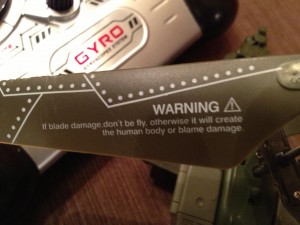On warning labels and remote control helicopters
This picture was forwarded to me by a friend after he purchased a remote control helicopter. Maybe Santa brought you one of these in your stocking as well. In case you can’t see the warning printed on the blade, it reads as follows:
WARNING. If blade damage, don’t be fly. otherwise it will create the human body or blame damage.
Clearly, this warning label has some problems, but we thought that it would be a great time to review warnings standards, and discuss specifically what the drafter could have done better (at least under South Carolina law). First, when is a warning required in the first place? Basically, if it is foreseeable that users might need to be warned about the precise risk involved with using a product, it will be required. See, e.g. Madden v. Cox, 284 S.C. 574, 328 S.E.2d 108 (Ct. App. 1995). Warnings are not required when the danger is open and obvious to the user. Moore v. Barony House Rest., LLC, 382 S.C. 35, 41, 674 S.E.2d 500, 504 (Ct. App. 2009). The issue of foreseeability has been the subject of litigation as well–how broadly should a manufacturer foresee that the product will be used, either appropriately (intended use) or inappropriately (non-intended use)? One case provides a good guide:
“Intended use” is but a convenient adaptation of the basic test of “reasonable foreseeability” framed to more specifically fit the factual situations out of which arise questions of a manufacturer’s liability for negligence. “Intended use” is not an inflexible formula to be apodictically applied to every case. Normally a seller or manufacturer is entitled to anticipate that the product he deals in will be used only for the purposes for which it is manufactured and sold; thus he is expected to reasonably foresee only injuries arising in the course of such use.
However, he must also be expected to anticipate the environment which is normal for the use of his product and where, as here, that environment is the home, he must anticipate the reasonably foreseeable risks of the use of his product in such an environment. These are risks which are inherent in the proper use for which his product is manufactured.
The warning must be appropriate; implicit in the duty to warn is the duty to warn with a degree of intensity that would cause a reasonable man to exercise for his own safety the caution commensurate with the potential danger. From this it follows that the likelihood of an accident taking place and the seriousness of the consequences are always pertinent matters to be considered with respect to the duty to provide a sufficient warning label, and that there is a particular need for a sufficient warning where there is a representation that the product in question is not dangerous.
In the case of our remote control helicopter, I think it’s a safe bet to say that there would be enough evidence to get to a jury on the issue of the adequacy of this warning. If anyone has any arguments, please let me know.


















